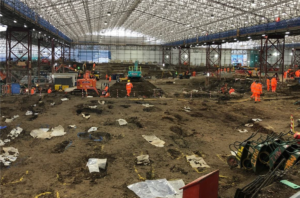Andrea Bradley, HS2 Ltd
This work has involved collaboration from colleagues across the academic community as well as from within HS2’s supply chain of specialist and technical organisations. Among attendees at an initial workshop in 2019 hosted by HS2 Ltd and Historic England, to develop collaborative research ideas and a partnership working approach, were more than a dozen research institutions including the Universities of Oxford, Durham, Cambridge, Bradford, London, York, Southampton and Liverpool John Moores, as well as the Francis Crick Institute.
HS2 Ltd have a research strategy (HERDS) that underpins all of the heritage and archaeological work on Phase 1 of the Project and extends to archaeological work carried out within the large burial grounds at Euston, Birmingham and Stoke Mandeville. HS2 are obliged under the High-Speed Rail Act (the Heritage Memorandum), to deliver a full programme of archaeology, including analysis and publication, as would be expected of any development project in the UK. It is a priority of HS2 as a publicly funded project to deliver knowledge creation, and to ensure that maximum public benefit is achieved from the archaeological work carried out on the Project.
However, HS2 recognise that there will be a point at which HS2’s commitments are met, but there is still enormous additional research potential in the data from the Project. This initiative was developed to start sharing data as soon as possible, so that others can think about how it might deliver their research strategies, projects and teaching. This will increase the impact of the work HS2 has done, beyond the limits and requirements of the project itself.
Many of the institutions named above are already involved in the analysis and further research on the burial grounds, through HS2 Ltd’s specialist supply chain. It is hoped that in future many more will be involved as partners of different types, delivering large-scale research, individual projects, PhDs and teaching programmes.
Collaboration started officially in September 2019 with the data-sharing workshop, at which participants were invited to hear about the latest results from the burial grounds and offer new or alternative research perspectives. The main aim and most significant outcome of this event was to establish a network of potential future partners, and to introduce partners to each other. This has resulted in a number of joint projects being developed to seek funding both from within and outside of HS2. As part of this process, partners are in ongoing dialogue with the team at HS2 and with their specialists.
While the legacy of the collaboration is still to be defined, it is likely to be a suite of research projects from high level and strategic scientific and biomolecular research down to community-based training and educational initiatives.
Lessons, particularly for future large-scale infrastructure projects might be – don’t be afraid to share, despite what you might perceive to be insurmountable barriers imposed by the governance of your project. They shouldn’t put you off. Also, share as early as possible, because the time it takes to develop working relationships and deliver results within project governance and other institutional parameters is longer even than you might imagine.

Bringing together senior members of staff from public and non-government bodies to work collaboratively on strategic matters for the historic environment sector.